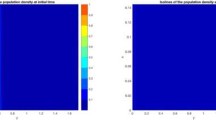Abstract
A specific regular inbreeding system of quadruple half-second cousin mating is considered. A regular inbreeding system can be thought of as a graph which satisfies certain natural homogeneity properties. Random walks X n and Y n are introduced on the nodes of the graph; the event {X n=Yn} is a renewal event by the homogeneity properties. In Arzberger (1985) it is shown that 1) graphs associated with left cancellative semigroups are regular, and 2) for regular systems, the population becomes genetically uniform if and only if the event {X n=Yn} is recurrent. In Arzberger (1986) the system of quadruple half-second cousin mating is associated with a cancellative semigroup, thus the system is regular. In this paper we show that 1) An is asymptotically of the form cn 3, where A n is the number of ancestors n generations into the past, 2) {X n=Yn} is not recurrent (this is shown by associating (X n, Y n) with a random walk in Z 3, 3) P[X 3n =Y 3n ] is asymptotically of the form cn −3/2. Thus, in this example, genetic heterogeneity is maintained, with a cubic rate of growth for An, not by an exponential growth rate, as in all previous examples of regular inbreeding systems in which genetic heterogeneity is maintained.
Similar content being viewed by others
References
Arzberger, P. W.: A probabilistic and algebraic treatment of regular inbreeding systems. J. Math. Biol. 22, 175–197 (1985)
Arzberger, P. W.: An example of a regular inbreeding system with cubic ancestral growth. Technical Report Number 791, Department of Statistics, University of Wisconsin-Madison (1986)
Arzberger, P. W.: The rate of convergence to genetic uniformity in the pedigree S= 〈a, b; (b 2 a, ab 2), (b 2, a 2 b)〉 (double half-first cousin mating). Technical Report Number 816, Department of Statistics, University of Wisconsin-Madison (1988)
Arzberger, P. W.: Results for generalized inbreeding systems. J. Math. Biol. 26, 535–550 (1988)
Boucher, W., Nagylaki, T.: Regular systems of inbreeding. J. Math. Biol. 26, 121–142 (1988)
Clifford, A. H., Preston, G. B.: The algebraic theory of semigroups, vol. 1. Ams. Math. Survey 7, (1961)
Crow, J. F., Kimura, M.: An introduction to population genetics theory. New York: Harper and Row 1970
Doyle, P. G., Snell, J. L.: Random walks and electric networks. M. A. A. 1984
Feller, W.: An introduction to probability theory and its applications, vol. 1, 3rd edn. New York: Wiley 1968
Jacquard, A.: The genetic structure of populations. New York Heidelberg Berlin: Springer 1974 (English translation; original in Masson et Cie 1970)
Kimura, M., Crow, J. F.: On the maximum avoidance of inbreeding. Genet. Res. 4, 399–415 (1963)
Malecot, G.: The mathematics of heredity. San Francisco: Freeman 1969 (English translation; original in Masson et Cie 1948)
Nagylaki, T.: Analysis of some regular systems of inbreeding. J. Math. Biol. 9, 237–244 (1980)
Wright, S.: Systems of mating. Genetics 6, 111–178 (1921)
Author information
Authors and Affiliations
Rights and permissions
About this article
Cite this article
Arzberger, P. An example of a regular inbreeding system with cubic ancestral growth that preserves some genetic variability. J. Math. Biology 26, 519–533 (1988). https://doi.org/10.1007/BF00276058
Received:
Revised:
Issue Date:
DOI: https://doi.org/10.1007/BF00276058




